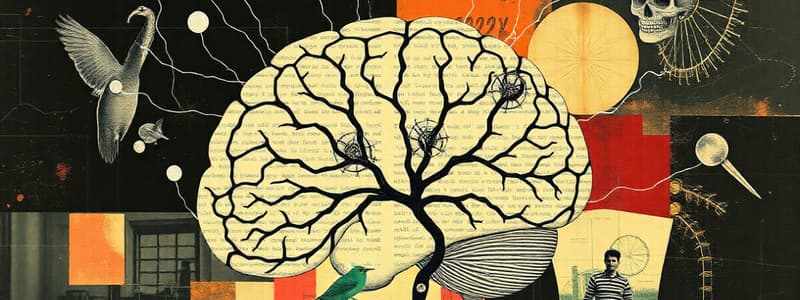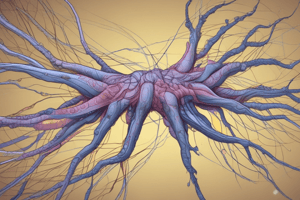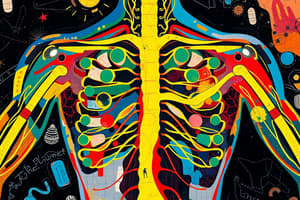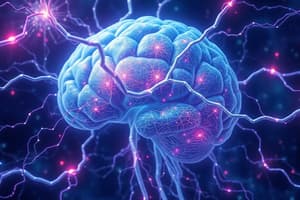Podcast
Questions and Answers
Which of the following is NOT a term used to describe white matter in the CNS?
Which of the following is NOT a term used to describe white matter in the CNS?
- Tracts
- Bundles
- Fascicle
- Nuclei (correct)
Which of the following terms describe a bundle of nerves below the conus medullaris?
Which of the following terms describe a bundle of nerves below the conus medullaris?
- Conus medullaris
- Cervical plexus
- Dorsal root ganglion
- Cauda equina (correct)
What does the term 'afferent' refer to in the context of the nervous system?
What does the term 'afferent' refer to in the context of the nervous system?
- The point where a neuron transmits a signal to another cell
- Motor signals traveling away from the CNS
- Nerve bundles connecting the two hemispheres of the brain
- Sensory signals traveling towards the CNS (correct)
In the spinal cord, where is grey matter located?
In the spinal cord, where is grey matter located?
What is the function of the dorsal root ganglion?
What is the function of the dorsal root ganglion?
Which of the following is NOT a part of the CNS?
Which of the following is NOT a part of the CNS?
During embryological development, the forebrain is also known as the:
During embryological development, the forebrain is also known as the:
Which of the following is TRUE about the space within the neural tube during embryonic development?
Which of the following is TRUE about the space within the neural tube during embryonic development?
What are the two main cell types that make up nervous tissue?
What are the two main cell types that make up nervous tissue?
What is the function of myelin?
What is the function of myelin?
Where does communication between neurons occur?
Where does communication between neurons occur?
What is the name of the electrical change in the postsynaptic cell as a result of neurotransmitter binding?
What is the name of the electrical change in the postsynaptic cell as a result of neurotransmitter binding?
Which of the following is NOT a characteristic of myelinated axons?
Which of the following is NOT a characteristic of myelinated axons?
What type of neurons are primarily found in Layer IV of the neocortex?
What type of neurons are primarily found in Layer IV of the neocortex?
Which layer of the neocortex is primarily composed of dendrites and some axons from deeper layers?
Which layer of the neocortex is primarily composed of dendrites and some axons from deeper layers?
Which part of the brainstem is responsible for connecting the cerebellum to the brain?
Which part of the brainstem is responsible for connecting the cerebellum to the brain?
What anatomical structure is associated with the processing of auditory information in the brainstem?
What anatomical structure is associated with the processing of auditory information in the brainstem?
Which of the following accurately describes the function of the parietal lobe?
Which of the following accurately describes the function of the parietal lobe?
Which brain structure is separated by the lateral fissure?
Which brain structure is separated by the lateral fissure?
What does the central sulcus of Rolando separate?
What does the central sulcus of Rolando separate?
Wernicke’s area is primarily responsible for which function?
Wernicke’s area is primarily responsible for which function?
Which area is adjacent to the primary motor cortex and controls movement of the face and tongue?
Which area is adjacent to the primary motor cortex and controls movement of the face and tongue?
Which sulcus separates the parietal lobe from the occipital lobe on a midsagittal cut?
Which sulcus separates the parietal lobe from the occipital lobe on a midsagittal cut?
Which type of association cortex is located next to primary cortices?
Which type of association cortex is located next to primary cortices?
What is the clinical term for the deficit associated with damage to Wernicke’s area?
What is the clinical term for the deficit associated with damage to Wernicke’s area?
What is the function of the corpus callosum?
What is the function of the corpus callosum?
Flashcards
Grey matter location
Grey matter location
Grey matter is on the brain's periphery and deep clusters, while in the spinal cord, it's deep within.
White matter terminology
White matter terminology
White matter includes terms like tracts, bundles, and commissures in the CNS.
Spinal nerve structure
Spinal nerve structure
Each spinal nerve consists of a dorsal root (sensory), dorsal root ganglion, and ventral root (motor).
Conus medullaris
Conus medullaris
Signup and view all the flashcards
Hemispheres of the brain
Hemispheres of the brain
Signup and view all the flashcards
Nervous System Divisions
Nervous System Divisions
Signup and view all the flashcards
Central Nervous System (CNS)
Central Nervous System (CNS)
Signup and view all the flashcards
Peripheral Nervous System (PNS)
Peripheral Nervous System (PNS)
Signup and view all the flashcards
Neurons
Neurons
Signup and view all the flashcards
Glial Cells
Glial Cells
Signup and view all the flashcards
Synaptic Transmission
Synaptic Transmission
Signup and view all the flashcards
EPSP and IPSP
EPSP and IPSP
Signup and view all the flashcards
Myelinated Axons
Myelinated Axons
Signup and view all the flashcards
Neocortex Layers
Neocortex Layers
Signup and view all the flashcards
Layer I of Neocortex
Layer I of Neocortex
Signup and view all the flashcards
Layer IV Function
Layer IV Function
Signup and view all the flashcards
Motor/Sensory Homunculi
Motor/Sensory Homunculi
Signup and view all the flashcards
Brainstem Components
Brainstem Components
Signup and view all the flashcards
Lateral fissure
Lateral fissure
Signup and view all the flashcards
Central sulcus
Central sulcus
Signup and view all the flashcards
Parietooccipital sulcus
Parietooccipital sulcus
Signup and view all the flashcards
Primary motor cortex
Primary motor cortex
Signup and view all the flashcards
Primary sensory cortex
Primary sensory cortex
Signup and view all the flashcards
Wernicke's area
Wernicke's area
Signup and view all the flashcards
Broca's area
Broca's area
Signup and view all the flashcards
Unimodal vs Heteromodal association cortices
Unimodal vs Heteromodal association cortices
Signup and view all the flashcards
Study Notes
Overview and Organization of the Nervous System
- The nervous system is structurally divided into the central nervous system (CNS) and the peripheral nervous system.
Review: The Nervous System
- The CNS includes the brain and spinal cord.
- The peripheral nervous system includes cranial nerves and ganglia, spinal nerves and ganglia, autonomic nerves and ganglia, and the enteric nervous system.
CNS Development
- The CNS develops from infolding of the ectoderm, forming a neural tube.
- Folds and outpouchings within the tube give rise to different parts of the CNS.
- The space within the tube becomes the ventricles and central canal, filled with cerebrospinal fluid (CSF).
- The brain is subdivided based on embryological origins: forebrain (prosencephalon), midbrain (mesencephalon), and hindbrain (rhombencephalon).
- Each of those structures have different further subdivisions, which are highlighted in a diagram.
Orientation of the CNS
- Directional terms are used to describe the CNS's structure and organization.
- Terms such as superior, inferior, anterior, posterior, dorsal, ventral, rostral, and caudal are used.
- A diagram illustrates the different ways of visualizing those terms.
- The midbrain-diencephalic junction is highlighted as an important landmark.
Overview of CNS Histology
- Nervous tissue is composed of neurons (the parenchymal cells) and glial cells (the stromal cells).
- Typical neurons have a cell body, dendrites, an axon, axon collaterals, and axon terminals.
- The axon is covered in segments of myelin (internodes) separated by Nodes of Ranvier
Structural Classification of Neurons
- Neurons are classified based on their structure.
- The image displays a diagram showing different types of neurons (unipolar, bipolar, pseudounipolar and multipolar)
Review of Neuronal Function
- Communication between neurons is at synapses.
- Neurotransmitters are released at the presynaptic terminal and diffuse across the synaptic cleft to bind with receptors on the postsynaptic terminal.
- Ion channels on the postsynaptic membrane open or close, creating excitatory (EPSP) or inhibitory (IPSP) postsynaptic potentials.
- Summation of these potentials leads to action potentials.
Overview of Nervous Tissue
- Myelinated axons appear paler than other parts of a neuron.
- White matter is primarily composed of myelinated axons. Grey matter is not myelinated.
- The arrangement of white and grey matter differs in the brain and spinal cord.
Overview of Brain Structure
- The brain is divided into four lobes (frontal, parietal, temporal, and occipital).
- Fissures and sulci divide the lobes and form gyri.
- The diagram illustrates the major brain lobes' visualization.
- Details of specific sulci and gyri, like the central sulcus, lateral sulcus, parieto-occipital sulcus, and various gyri (precentral, postcentral, superior/middle/inferior frontal/parietal/temporal/occipital)
Primary Cortices
- Structures within the brain are designated as primary cortices.
- Primary motor cortices are responsible for initiating voluntary muscle movement.
- Primary sensory cortex is responsible for processing sensory information.
- Primary visual cortex is responsible for processing visual information.
- Primary auditory cortex is responsible for processing auditory information.
Association Areas of the Neocortex
- Unimodal association areas are located near primary areas and process info from a single modality.
- Heteromodal association areas are further from primary areas and process info from multiple modalities.
- Wernicke's area is critical for language comprehension.
- Broca's area is critical for language production.
Other Cortical Areas
- Brodmann's cytoarchitectural areas refer to areas in the brain which have similar cytoarchitecture.
- Wilder Penfield helped solidify understanding of cortical functions by mapping different functions of the brain.
Histology of the Neocortex
- The neocortex consists of 6 layers arranged from outer to inner.
- Details of the function of the different layers are provided.
- Diagramatic representation of the layers in a section of the brain is provided.
Overview of the Brainstem
- Structures of the brainstem are noted, including; cranial nerves I-XII, midbrain (including the interpeduncular fossa and cerebral peduncles (crus cerebri)), pons, the pontomedullary junction, the medulla oblongata, Pyramids, & Olives.
Overview of the Brain
- Structures of the brain are noted. These include; pineal gland, superior colliculus, brachium of superior colliculus, lateral geniculate body, inferior colliculus, brachium of inferior colliculus, medial geniculate body, & superior cerebellar peduncle.
Overview of the Brainstem (Additional Areas)
- Additional structures of the brainstem are listed, including middle cerebellar peduncle, inferior cerebellar peduncle, cuneate tubercle, gracile tubercle and facial tubercle.
Overview of Spinal Cord Structure
- Spinal nerves (33 pairs).
- Cervical and lumbar enlargements
- Cervical, brachial, lumbar, and sacral plexuses.
- Conus medullaris and cauda equina.
Overview of Spinal Cord Structure (Spinal Nerves)
- Each spinal nerve is formed from dorsal and ventral roots.
- Dorsal root is sensory; Ventral root is motor.
- Ganglion associated with dorsal root.
- Rami are the branches from spinal nerves.
Autonomic Nervous System Overview
- Diagram illustrating the sympathetic and parasympathetic pathways
Studying That Suits You
Use AI to generate personalized quizzes and flashcards to suit your learning preferences.




